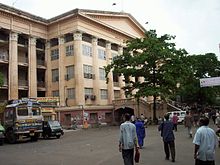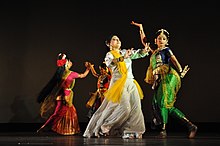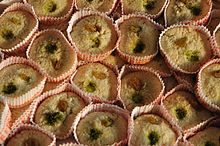Healthcare
See also: Health care in Kolkata

Calcutta Medical College, the second institution in Asia to teach modern medicine(after 'Ecole de Médicine de Pondichéry')
As of 2011, the health care system in Kolkata consists of 48 government hospitals, mostly under the Department of Health & Family Welfare, Government of West Bengal, and 366 private medical establishments;[171] these establishments provide the city with 27,687 hospital beds.[171] For every 10,000 people in the city, there are 61.7 hospital beds,[172] which is higher than the national average of 9 hospital beds per 10,000.[173] Ten medical and dental colleges are located in the Kolkata metropolitan area which act astertiary referral hospitals in the state.[174][175] Calcutta Medical College, founded in 1835, was the first institution in Asia to teach modern medicine.[176]These facilities are inadequate to meet the healthcare needs of the city.[177][178][179] More than 78% in Kolkata prefer the private medical sector over the public medical sector,[113]:109due to the poor quality of care, the lack of a nearby facility, and excessive waiting times at government facilities.[113]:61
According to the 2005 National Family Health Survey, only a small proportion of Kolkata households were covered under any health scheme or health insurance.[113]:41 The total fertility rate in Kolkata was 1.4, which was the lowest among the eight cities surveyed.[113]:45In Kolkata, 77% of the married women used contraceptives, which was the highest among the cities surveyed, but use of modern contraceptive methods was the lowest (46%).[113]:47 The infant mortality rate in Kolkata was41 per 1,000 live births, and the mortality rate for children under five was49 per 1,000 live births.[113]:48
Among the surveyed cities, Kolkata stood second (5%) for children who had not had any vaccinations under theUniversal Immunization Programme as of 2005.[113]:48 Kolkata ranked second among the surveyed cities, with access to an anganwadi centre under theIntegrated Child Development Services(ICDS) programme for 57% of the children between 0 and 71 months.[113]:51 The proportion ofmalnourished, anaemic and underweightchildren in Kolkata was less in comparison to other surveyed cities.[113]:54–55
About 18% of the men and 30% of the women in Kolkata are obese—the majority of them belonging to the non-poor strata of society.[113]:105 In 2005, Kolkata had the highest percentage (55%) among the surveyed cities of anaemic woman, while 20% of the men in Kolkata were anaemic.[113]:56–57Diseases like diabetes, asthma, goitreand other thyroid disorders were found in large numbers of people.[113]:57–59Tropical diseases like malaria, dengueand chikungunya are prevalent in Kolkata, though their incidence is decreasing.[180][181] Kolkata is one of the districts in India with a high number of people with AIDS; it has been designated a district prone to high risk.[182][183]
Because of higher air pollution, the life expectancy of a person born in the city in 2014, is four years fewer than in the suburbs.[184]
Education
Main article: Education in Kolkata

The University of Calcutta, a renowned seat of learning and the oldest Western-style university in South Asia

The Indian Institute of Management Calcutta at Joka, a well-known business school
Kolkata's schools are run by the state government or private organisations, many of which are religious. Bengali and English are the primary languages of instruction; Urdu and Hindi are also used, particularly in central Kolkata.[185][186] Schools in Kolkata follow the "10+2+3" plan. After completing their secondary education, students typically enroll in schools that have a higher secondary facility and are affiliated with the West Bengal Council of Higher Secondary Education, theICSE, or the CBSE.[185] They usually choose a focus on liberal arts, business, or science. Vocational programs are also available.[185]
As of 2010, the Kolkata urban agglomeration is home to 14 universities run by the state government.[187] The colleges are each affiliated with a university or institution based either in Kolkata or elsewhere in India. Aliah University which was founded in 1780 as Mohammedan College of Calcutta is the oldest post-secondary educational institution of the city.[188] The University of Calcutta, founded in 1857, is the first modern university in South Asia.[189]Bengal Engineering and Science University (BESU) is the second oldest engineering institution of the country located in Howrah.[190] An Institute of National Importance, BESU was converted to India's first IIEST. Jadavpur University is known for its arts, science, and engineering faculties.[191] TheIndian Institute of Management Calcutta, which was the first of the Indian Institutes of Management, was established in 1961 at Joka, a locality in the south-western suburbs.[192] TheWest Bengal National University of Juridical Sciences is one of India'sautonomous law schools,[193][194] and the Indian Statistical Institute is a public research institute and university.
Notable scholars who were born, worked or studied in Kolkata include physicistsSatyendra Nath Bose, Meghnad Saha,[195] and Jagadish Chandra Bose;[196] chemist Prafulla Chandra Roy;[195] statistician Prasanta Chandra Mahalanobis;[195] physicianUpendranath Brahmachari;[195] educatorAshutosh Mukherjee;[197] and Nobel laureates Rabindranath Tagore,[198] C. V. Raman,[196] and Amartya Sen.[199]
Kolkata houses many premier research institutes like Indian Association for the Cultivation of Science (IACS), Indian Institute of Chemical Biology (IICB),Indian Institute of Science Education and Research (IISER), Bose Institute,Saha Institute of Nuclear Physics (SINP),All India Institute of Hygiene and Public Health, Central Glass and Ceramic Research Institute (CGCRI), S.N. Bose National Centre for Basic Sciences(SNBNCBS), Indian Institute of Social Welfare and Business Management(IISWBM), National Institute of Pharmaceutical Education and Research, Kolkata, Variable Energy Cyclotron Centre (VECC) and Indian Centre for Space Physics. Nobel laureate Sir C. V. Raman did his groundbreaking work in Raman effect in IACS.
Culture
Main article: Kolkata culture

Dance accompanied by Rabindra Sangeet, a music genre started by Rabindranath Tagore
Kolkata is known for its literary, artistic, and revolutionary heritage; as the former capital of India, it was the birthplace of modern Indian literary and artistic thought.[200] Kolkata has been called the "City of Furious, Creative Energy"[201] as well as the "cultural [or literary] capital of India".[202][203] The presence of paras, which are neighbourhoods that possess a strong sense of community, is characteristic of the city.[204] Typically, each para has its own community club and, on occasion, a playing field.[204]Residents engage in addas, or leisurely chats, that often take the form of freestyle intellectual conversation.[205][206] The city has a tradition of political graffiti depicting everything from outrageous slander to witty banter and limericks, caricatures, and propaganda.[207][208]
Kolkata has many buildings adorned with Indo-Islamic and Indo-Saracenicarchitectural motifs. Several well-maintained major buildings from the colonial period have been declared "heritage structures";[209] others are in various stages of decay.[210][211]Established in 1814 as the nation's oldest museum, the Indian Museumhouses large collections that showcaseIndian natural history and Indian art.[212]Marble Palace is a classic example of a European mansion that was built in the city. The Victoria Memorial, a place of interest in Kolkata, has a museum documenting the city's history. TheNational Library of India is the leading public library in the country whileScience City is the largest science centre in the Indian subcontinent.[213]
The popularity of commercial theatres in the city has declined since the 1980s.[214]:99[215] Group theatres of Kolkata, a cultural movement that started in the 1940s contrasting with the then-popular commercial theatres, are theatres that are not professional or commercial, and are centres of various experiments in theme, content, and production;[216] group theatres use theproscenium stage to highlight socially relevant messages.[214]:99[217] Chitpurlocality of the city houses multiple production companies of jatra, a tradition of folk drama popular in rural Bengal.[218][219] Kolkata is the home of the Bengali cinema industry, dubbed "Tollywood" for Tollygunj, where most of the state's film studios are located.[220]Its long tradition of art films includes globally acclaimed film directors such as Academy Award-winning directorSatyajit Ray, Ritwik Ghatak, Mrinal Sen,Tapan Sinha, and contemporary directors such as Aparna Sen,Buddhadeb Dasgupta, and Rituparno Ghosh.[221]
During the 19th and 20th centuries,Bengali literature was modernised through the works of authors such asIshwar Chandra Vidyasagar, Bankim Chandra Chattopadhyay, Michael Madhusudan Dutt, Rabindranath Tagore,Kazi Nazrul Islam, and Sarat Chandra Chattopadhyay.[222] Coupled with social reforms led by Ram Mohan Roy, Swami Vivekananda, and others, this constituted a major part of the Bengal Renaissance.[223] The middle and latter parts of the 20th century witnessed the arrival of post-modernism, as well as literary movements such as those espoused by the Kallol movement,hungryalists and the little magazines.[224] Large majority of publishers of the city is concentrated in and around College Street, "...a half-mile of bookshops and bookstalls spilling over onto the pavement", selling new and used books.[225]
Kalighat painting originated in 19th century Kolkata as a local style that reflected a variety of themes including mythology and quotidian life.[226] TheGovernment College of Art and Craft, founded in 1864, has been the cradle as well as workplace of eminent artists including Abanindranath Tagore, Jamini Roy, and Nandalal Bose.[227] The art college was the birthplace of the Bengal school of art that arose as an avant garde and nationalist movement reacting against the prevalent academic art styles in the early 20th century.[228][229] The Academy of Fine Arts and other art galleries hold regular art exhibitions. The city is recognised for its appreciation of rabindrasangeet(songs written by Rabindranath Tagore) and Indian classical music, with important concerts and recitals, such asDover Lane Music Conference, being held throughout the year; Bengali popular music, including baul folk ballads, kirtans, and Gajan festival music; and modern music, including Bengali-language adhunik songs.[230][231] Since the early 1990s, new genres have emerged, including one comprising alternative folk–rock Bengali bands.[230]Another new style, jibonmukhi gaan("songs about life"), is based onrealism.[214]:105
Key elements of Kolkata's cuisineinclude rice and a fish curry known asmachher jhol,[232] which can be accompanied by desserts such asroshogolla, sandesh, and a sweet yoghurt known as mishti dohi. Bengal's large repertoire of seafood dishes includes various preparations of ilish, a fish that is a favourite among Calcuttans. Street foods such as beguni (fried battered eggplant slices), kati roll (flatbread roll with vegetable or chicken, mutton, or egg stuffing), phuchka (a deep-fried crêpe with tamarind sauce) and Indian Chinese cuisine from Chinatown are popular.[233][234][235][236] Sweets play a large part in the diet of Kolkatans—especially at their social ceremonies.[237]
Though Bengali women traditionally wear the sari, the shalwar kameez and Western attire is gaining acceptance among younger women.[238] Western-style dress has greater acceptance among men, although the traditionaldhoti and kurta are seen during festivals.Durga Puja, held in September–October, is Kolkata's most important festival; it is an occasion for glamorous celebrations.[239][240] The Bengali New Year, known as Poila Boishak, as well as the harvest festival of Poush Parbon are among the city's other festivals; also celebrated are Jagaddhatri Puja, Diwali,Saraswati Puja, Eid, Holi, Christmas, andRath Yatra. Cultural events include theKolkata Book Fair, the Dover Lane Music Festival, the Kolkata Film Festival,Nandikar's National Theatre Festival and the Statesman Vintage & Classic Car Rally.





No comments:
Post a Comment